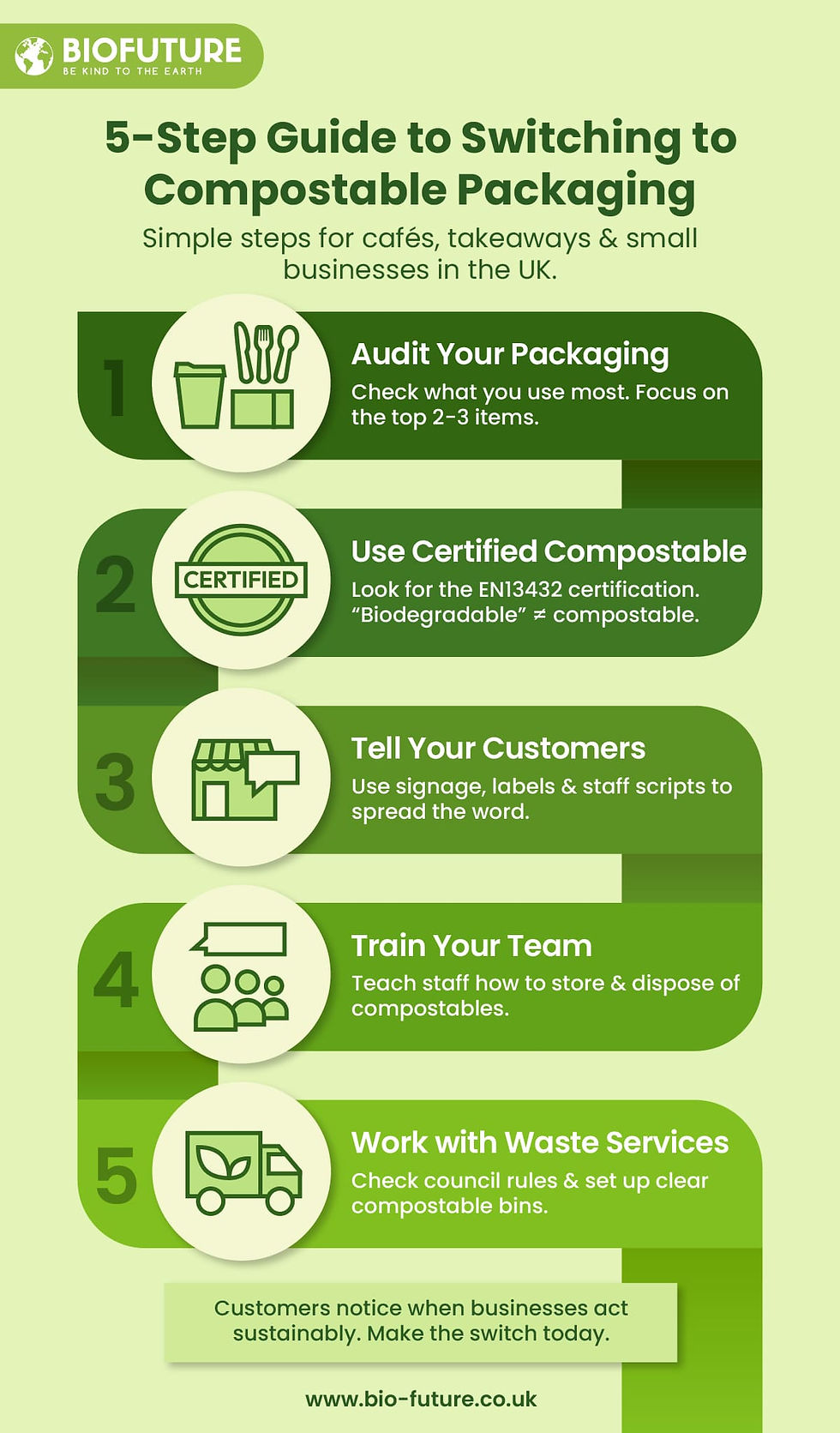Switching to Compostable Food Packaging: A Small Business Guide
- Biofuture

- Aug 18
- 4 min read
Updated: Oct 9

Why Small Businesses Are Making the Switch
If you run a café, takeaway, or food stall, you’ve probably noticed the shift: more customers are asking about eco-friendly options, and UK regulations are making plastic harder (and more expensive) to use. The Plastic Packaging Tax and single-use bans aren’t just aimed at big corporations, they affect everyone.
The good news? Moving to compostable packaging doesn’t have to be complicated or costly. In fact, done the right way, it can save you money, win customer loyalty, and future-proof your business. Here’s a simple five-step guide to help you make the switch with confidence. At Biofuture, we provide certified compostable packaging and kitchen essentials for UK cafés, takeaways, and households, so you can make the switch without compromise on quality or service.

Step 1: Audit Your Current Packaging
Before you start buying anything new, take a good look at what you’re using now. Which items do you go through the most? Cups? Clamshell boxes? Cutlery?
Create a quick list with:
How many you order per month
How much you’re spending
How much waste is being created
Most businesses find that just two or three packaging types make up the bulk of their orders. Those are the best places to start, small swaps with the biggest impact.
Step 2: Choose Certified Compostables (Not Just “Biodegradable”)
A lot of packaging is marketed as biodegradable, and many people assume that means the same thing as compostable. The truth is, they’re not the same.
“Biodegradable” simply means a material will eventually break down, but it doesn’t say how long that takes or what it leaves behind. Some “biodegradable” plastics can linger for years and release microplastics in the process.
That’s why it’s important to check for EN 13432 certification. This standard guarantees the packaging is genuinely compostable, meaning it will break down in industrial composting without leaving harmful residues.
So if you see the word biodegradable on a product, don’t take it at face value, look for proof it’s also certified compostable. That’s how you know you’re making a swap that’s genuinely good for your business and the environment.
But What About Recyclable Packaging?
Many businesses stick with “recyclable” packaging, thinking it’s the safest eco option. The issue is that very little of it actually gets recycled. In the UK, large amounts of recyclable waste end up in landfill or incineration because of contamination or lack of facilities. For example, takeaway coffee cups are technically recyclable, but because of their plastic lining, less than 1 in 400 actually are. That’s why compostable packaging, backed by proper certification, is a more reliable choice.
Step 3: Communicate the Change to Customers
Switching packaging isn’t just about what you buy, it’s about how you present it. Customers love to see businesses taking action, but they need clear information.
Add a small sign on your counter or table saying “This packaging is certified compostable.”
Post about the change on your social media.
Train your staff to mention it casually when serving: “Your coffee cup is compostable, just pop it in our compost bin after use.”
By making the switch visible, you show customers you’re serious about sustainability and give them a reason to keep supporting your business.
Step 4: Train Your Team and Adjust Operations
Your staff are the front line of this change. Make sure they know:
Which packaging is compostable
How to store it (compostables prefer dry, cool storage)
Where it should be disposed of
These are small adjustments, but consistency matters. If your team can explain the change with confidence, customers will trust it more.
Step 5: Work with Waste Providers to Ensure Composting
Here’s the catch: compostable packaging only works if it actually gets composted. In the UK, not every council food waste bin accepts compostable cups or boxes. If they end up in landfill, they won’t break down properly.
What you can do:
Check your local council’s rules (they vary widely).
Talk to your commercial waste provider, as many now offer compostable collection.
Provide clearly labelled bins for customers if you run a busy café or venue.
By closing the loop, you make sure your eco-efforts aren’t wasted.
Many of Biofuture’s business customers find success by pairing our certified compostable packaging with dedicated collection services, ensuring their eco-efforts don’t end up in landfill.
Common Mistakes to Avoid
Buying “biodegradable” instead of compostable. They are not always the same thing.
Mixing compostables into plastic recycling. This contaminates both streams.
Not telling customers. If they don’t know what it is, they’ll just throw it in the general bin.
Over-ordering before testing. Start small, get feedback, and scale up.
The Benefits Beyond the Bin
Switching isn’t just about compliance. It’s about building a stronger business:
Customers increasingly expect sustainable options, 61% of UK adults say they’ve cut back on single-use plastics.
Compostable packaging helps you stand out from competitors who stick with plastic.
It shows you’re future-focused, not scrambling when regulations change.
Most importantly, it proves that sustainability doesn’t have to come at a premium. It’s about smarter choices, not bigger costs.
Take the First Step and Make the Switch
Switching to compostable packaging isn’t a headache, it’s a step forward. Start with the biggest-impact items, make your changes visible, and get your waste provider on board.
With each small shift, you’ll build trust, strengthen your brand, and do right by your customers and the planet. And if you’re ready to start, you can explore our certified compostable takeaway packaging, from cups and straws to clamshell boxes and cutlery. Making the switch helps you reduce plastic waste, plant trees, support ongoing environmental initiatives, and show customers you care.




Comments